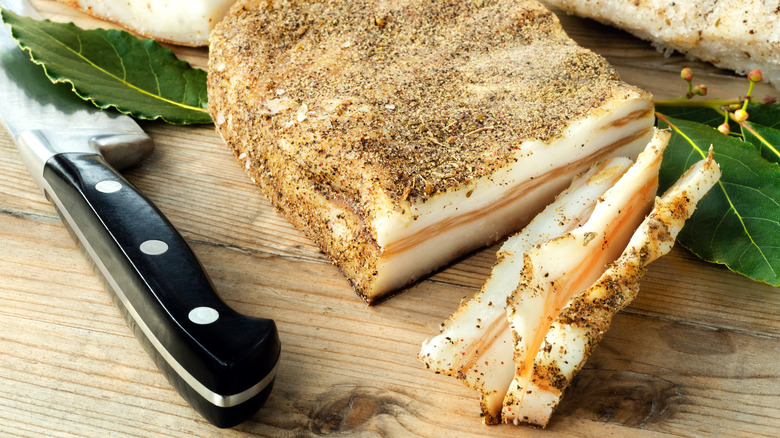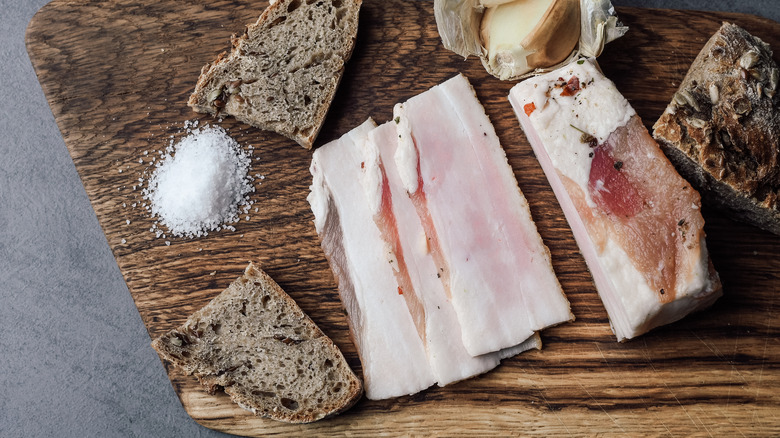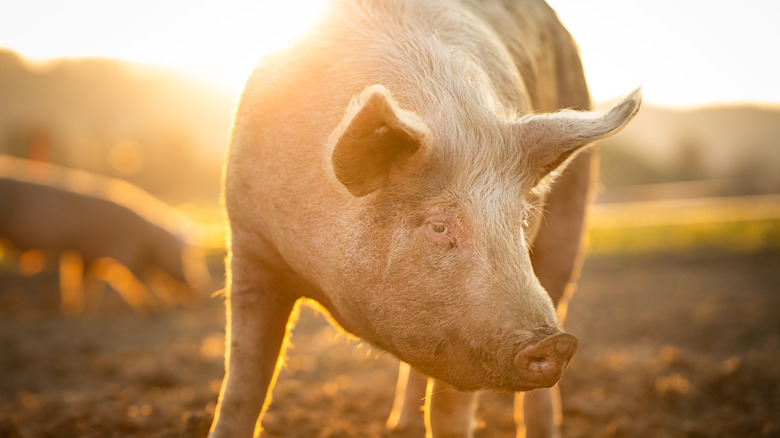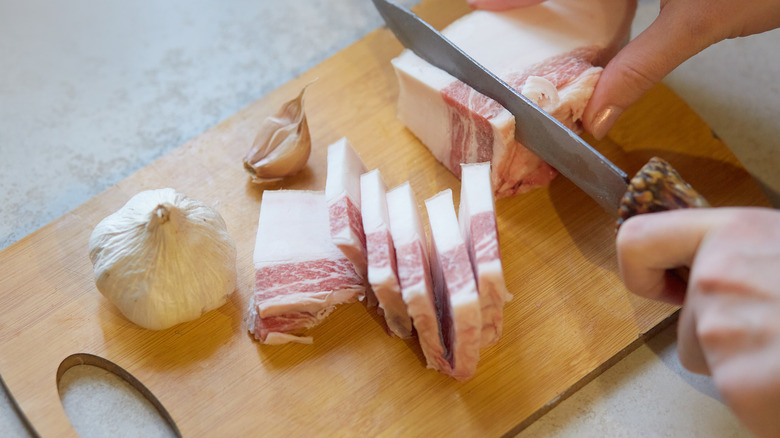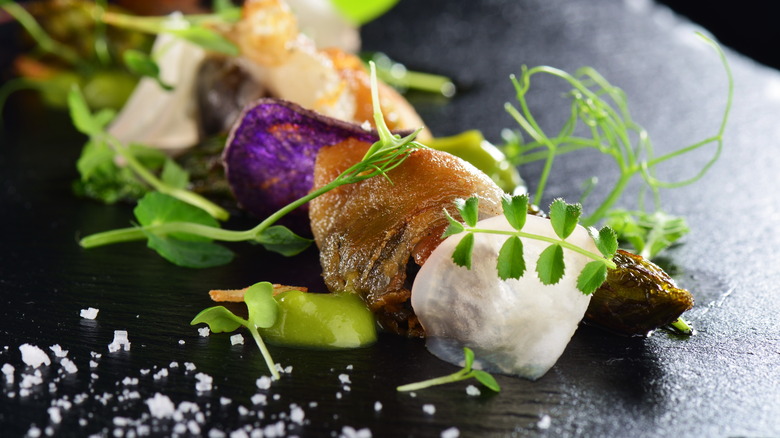What Is Lardo And What Does It Taste Like?
If you are on the hunt for a rich and decadent delicacy that you can add to your go-to list of gourmet ingredients, consider adding "Lardo" to your repertoire. Sometimes referred to as nature's porky answer to butter, lardo is also known as "pig butter," "prosciutto bianco," or "salo" (via The Guardian). Italian in origin, lardo is the cured (either salted or smoked with herbs and seasonings) fat from the back of a pig that is usually located just beneath the rind (via La Cucina Italiana).
In its most pure form, lardo is simply pork fat that has been elevated to dizzying heights with its elegant yet simple sophistication. Most purists would agree that the best way to enjoy lardo is in its simplest form, which is raw and spread or placed on a slice of bread or crostini. Alternatively, it can be used as a luxurious addition to a homemade charcuterie board (via The Spruce Eats). It's a throwback from a bygone era that is staking its claims in the modern era and garnering the attention of food aficionados everywhere.
What is lardo?
The two most popular types of lardo come from Northern Italy. This includes the Arnad variety from the Aosta Valley (via La Cucina Italiana) and the Lardo di Colonnata, which hails from the village of Colonnata in Tuscany near the Apuan Alps (via Great Italian Chefs). Some might say that Lardo di Colonnata is one of the most highly coveted types of lardo on the market today.
In an article from Great Italian Chefs, tour guide Fabrizio Cattani said, "No one really knows for sure the origin of lardo. But it could go back as far as the Roman period, when the miners needed a way to preserve pork. In the country there are marble basins from as early as the seventeenth century, and on the facade of some buildings in Colonnata there are visible artworks that depict the ancient curing techniques from around the nineteenth century."
How is lardo made?
According to Gastro Chemist, there is no one right way to make lardo. Fundamentally, it is all about the quality of the back fat being used (preferably pigs that are raised to make lardo), the spices and herbs being used, and the time invested in the process, which can continue for months or even years. The main thing is to be sure to properly cure the pork fat because it essentially is 100% fat. It can be cured by slowly brining with salt and herbs or it can be dry-cured by brining it, then hanging it out to dry before serving.
Traditional Lardo di Colonnata is a laborious process. Some producers use large marble stone vats to brine their lardo. They meticulously blend the fat with spices such as sea salt, and also add things like cinnamon, nutmeg, cloves, sage, oregano, laurel, star anise, and thyme. The interaction between the marble vats, the salt, and the other seasonings is crucial to giving Lardo di Colonnata its highly coveted texture and flavor profile (via Slow Food Foundation for Biodiversity).
What does lardo taste like?
It must be stated that lardo is not a powerhouse of bold or strong, lingering flavors. The magic of this delicacy lays in its subtle yet denoting aromas, its creamy texture, and its delightful and ethereal mouthfeel.
An article shared by Eater in February 2015 draws attention to the similarities between the British version of lardo, which is called fatback, and its American counterpart, which is often referred to as "salt pork," especially in the southern regions. According to a report shared by The Spruce Eats, lardo boasts a buttery flavor and silky texture. When it is sliced very thin until it is almost translucent it delivers a rich umami flavor profile that is slightly herbaceous with a somewhat sweet porkiness that is truly unforgettable and extremely recognizable.
Lardo features a melt in your mouth porky perfection that will always leave you coming back for a second helping.
Nutritional information about lardo
While no one is going to suggest that consuming copious amounts of pure animal fat is a great thing for your health, changing attitudes towards the benefits of good fats versus bad fats are beginning to turn the tide around and breathe new life into the appreciation of lardo on restaurant menus and at consumers' tables (via The Guardian).
Lardo is now seen as less harmful than once thought. According to Mafalda, one of Tuscany's oldest producers of Lardo di Colonnata (established in 1930), their product's cholesterol content is almost non-existent, undergoes no chemical treatments, and does not contain preservatives. They additionally credit the quality of their ingredients and their technique for making their lardo unique.
According to a report from Eat.Drink.Learn in July 2019, lardo could be a benefit to one's health by helping to regulate insulin levels, lowering cholesterol, and potentially decreasing blood sugar levels.
How to cook with lardo
One of the many beautiful things about lardo is its versatility. Saveur recommends wrapping it around grilled vegetables, such as asparagus, and fresh fruit, like cantaloupe or honeydew melon. Other suggestions include pairing it with seafood, including peeled shrimp or steamed clams. Fine Cooking suggests adding it to polenta, risotto, or beans, and even placing a few slices onto a pizza for a more sumptuous experience.
Chef Marianne Lumb, owner of Marianne restaurant in London, is a huge proponent of lardo and in an article for The Guardian, she commented by saying, "I think it's so popular in my kitchen because it is so versatile," shared Lumb, "We introduced Lardo di Colonnata in our canapés by slicing it very thinly and using it instead of rice paper to wrap mint, radish and carrots. I also use it on a scallop dish, again sliced very thinly, and I gently blowtorch it so it goes translucent. It offers delicious flavour and also a real visual treat to a dish." It goes without saying that lardo should be at the top of every food aficionados list for decant foods to try.
